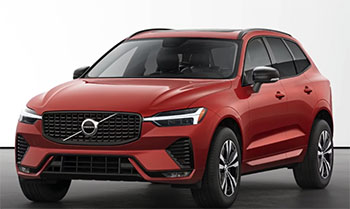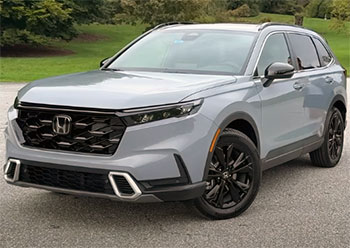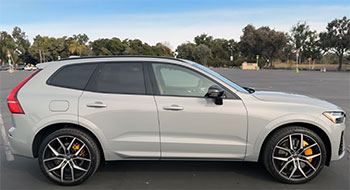I’ve always been fascinated by the choices we make when picking a car—how they reflect our priorities, lifestyles, and budgets. The Volvo XC60 and Honda CR-V, two heavyweights in the compact SUV arena, caught my eye recently, and I decided to explore them thoroughly.
My goal? To weigh their strengths and weaknesses, share my firsthand impressions, and help you decide which might fit your life best. This article compares their features, performance, and value, blending my experiences with a detailed breakdown to guide your next SUV purchase.
Comparison Table: Volvo XC60 vs. Honda CR-V
| Feature | Volvo XC60 | Honda CR-V |
|---|---|---|
| Starting MSRP | $47,843 | $31,804 |
| Engine | 2.0L Turbo 4-cylinder (247 hp) | 1.5L Turbo 4-cylinder (190 hp) |
| Fuel Economy (City/Highway/Combined) | 22/28/25 MPG | 28/34/30 MPG |
| Cargo Space (Seats Up/Down) | 17.1/63.3 cu ft | 39.3/76.5 cu ft |
| Passenger Space (Front/Rear Legroom) | 41.5/38.0 in | 41.3/41.0 in |
| Safety Rating (NHTSA) | 5 Stars | 5 Stars |
| Standard AWD | Yes | Optional |
| Base Trim Features | Leather upholstery, panoramic sunroof, semi-autonomous driving | Cloth seats, 7-inch touchscreen, adaptive cruise control |
| Reliability Rating (iSeeCars) | 8.2/10 | 9.0/10 |
| Towing Capacity | 3,500 lbs | 1,500 lbs |
My Experience With the Volvo XC60

I slid into the driver’s seat of the 2025 Volvo XC60, and it felt like stepping into a Scandinavian lounge.
The cabin’s understated elegance—think soft leather, a crystal gear selector, and a massive 9-inch touchscreen—made me feel like I was in a luxury hotel on wheels.
Driving through city streets, the XC60’s mild-hybrid engine delivered a smooth 247 horsepower, effortlessly merging onto highways.
Its all-wheel drive (standard across trims) gave me confidence on a rainy test drive, gripping the road without hesitation.
The semi-autonomous Pilot Assist system was a game-changer, subtly correcting my steering on long stretches, though it felt a bit intrusive on winding exits.
The XC60’s ride was quiet, almost serene, with the Harman Kardon sound system turning my commute into a concert. But I noticed the cargo space—17.1 cubic feet with seats up—was tighter than I’d hoped, especially when I tried loading groceries and a stroller.
The fuel economy, averaging 25 MPG combined, wasn’t stellar either, particularly compared to competitors. Still, the XC60’s safety features, like the driver’s side knee airbag and Volvo On Call GPS system, gave me peace of mind, especially imagining family road trips. The built-in child booster seats were a clever touch, folding seamlessly into the rear bench—a feature I wish more SUVs offered.
On a weekend trip, the XC60’s handling shone. Its double-wishbone suspension made cornering precise, though the steering felt a tad heavy at low speeds. The plug-in hybrid option (Recharge) intrigued me with its 455 horsepower, but the $59,345 starting price for that trim gave me pause. Maintenance is another consideration—Volvo covers three years or 36,000 miles, which is generous, but long-term costs loomed in my mind, especially given Volvo’s mixed reliability reputation.
My Experience With the Honda CR-V

The 2025 Honda CR-V welcomed me with a different vibe—practical, no-nonsense, yet surprisingly refined.
Its cabin, while not as plush as the XC60’s, felt airy and functional, with a clean dashboard inspired by the Honda Civic.
The 1.5-liter turbo engine, producing 190 horsepower, wasn’t as punchy as the XC60, but it got the job done for daily errands.
The CVT transmission had a slight drone during hard acceleration, but I appreciated the 30 MPG combined fuel economy, which saved me a few bucks at the pump.
Cargo space was a standout—39.3 cubic feet with seats up meant I could toss in sports gear, groceries, and even a small bike without folding seats.
The rear legroom (41 inches) made my taller friends comfortable, though the front legroom was a hair shy of the XC60’s. The CR-V’s safety suite, including adaptive cruise control and lane-keeping assist, felt robust, though its lane-centering tech added an artificial heft to the steering that I didn’t love. Both SUVs earned five-star NHTSA ratings, but the CR-V’s Top Safety Pick status from IIHS felt reassuring.
Driving the CR-V on a mountain road, I found its handling predictable but not thrilling. It leaned more toward comfort than sportiness, which suited my daily needs but left me wanting a bit more zest. The hybrid option (Sport trim, starting at $35,700) boosted efficiency and power, making it a compelling middle ground.
Honda’s reliability—rated 9.0/10 by iSeeCars—gave me confidence, and the lower starting price ($31,804) made it easier to justify extras like a sunroof or heated seats.
Read More: My Thoughts On Acura MDX Vs. Lexus GX
Pros Of the Volvo XC60
- Luxurious Interior: The XC60’s cabin feels like a premium retreat, with leather upholstery, a tailored steering wheel, and a crystal gear selector by Orrefors. It’s a step above most competitors in refinement.
- Powerful Performance: The standard 2.0-liter turbo engine delivers 247 horsepower, outmuscling the CR-V’s base engine. The plug-in hybrid Recharge trim offers a thrilling 455 horsepower.
- Standard All-Wheel Drive: AWD comes standard, enhancing traction in diverse conditions—perfect for rain-soaked commutes or light off-roading.
- Advanced Safety Features: Features like a driver’s side knee airbag, Volvo On Call GPS tracking, and semi-autonomous Pilot Assist set a high safety bar. The XC60’s IIHS Top Safety Pick+ rating is a bonus.
- Smooth Ride Quality: The double-wishbone suspension ensures precise handling and a cushioned ride, ideal for long drives or uneven roads.
- Generous Maintenance Plan: Volvo covers three years or 36,000 miles of scheduled maintenance, reducing early ownership costs.
- Unique Features: Built-in child booster seats and a Harman Kardon sound system add practical and premium touches that stand out in the segment.
The XC60’s interior was a highlight for me—every touchpoint felt thoughtfully crafted, from the soft leather seats to the intuitive touchscreen. On a test drive, the AWD system handled a slick road with ease, and the mild-hybrid tech gave a subtle boost in stop-start traffic.
The safety features, especially the knee airbag and Volvo On Call, made me feel secure, particularly when I imagined driving with kids. The maintenance plan was a nice perk, easing worries about early repair costs. However, the plug-in hybrid’s price jump made me question its value for my needs, though the power was tempting.
Cons Of the Volvo XC60
- Higher Price Point: Starting at $47,843, the XC60 is significantly pricier than the CR-V, with top trims and hybrids pushing past $60,000.
- Limited Cargo Space: With only 17.1 cubic feet behind the rear seats, the XC60 lags behind competitors like the CR-V for hauling gear.
- Mediocre Fuel Economy: The 25 MPG combined rating trails the CR-V’s 30 MPG, and the XC60 requires premium fuel, adding to costs.
- Questionable Reliability: iSeeCars rates the XC60 at 8.2/10 for reliability, lower than the CR-V’s 9.0/10, raising concerns about long-term maintenance.
- Heavy Steering at Low Speeds: The steering can feel overly firm in tight spaces, like parking lots, which was noticeable during my test drive.
- Complex Infotainment: The 9-inch touchscreen, while sleek, has a learning curve, and I found myself fumbling with controls more than I’d like.
- Higher Ownership Costs: Insurance and maintenance costs are steeper than the CR-V’s, especially beyond the covered maintenance period.
The XC60’s price tag hit me hard when I compared it to the CR-V’s affordability. Loading up cargo for a weekend trip was a squeeze, and the fuel costs added up quicker than I expected, especially since I had to spring for premium gas.
Reliability concerns lingered in my mind—posts on forums like Reddit echoed worries about long-term upkeep. The steering felt cumbersome in tight spots, and the infotainment system, while pretty, frustrated me when I couldn’t quickly adjust settings. These drawbacks made me weigh whether the luxury was worth the trade-offs.
Pros Of the Honda CR-V
- Affordable Pricing: Starting at $31,804, the CR-V is nearly $16,000 less than the XC60, making it easier to add options like a hybrid powertrain or upgraded trim.
- Excellent Fuel Economy: The 30 MPG combined rating (34 MPG highway) beats the XC60, and it runs on regular unleaded, saving money at the pump.
- Spacious Cargo Area: With 39.3 cubic feet behind the rear seats and 76.5 cubic feet with seats folded, the CR-V is a hauler’s dream.
- Strong Reliability: iSeeCars gives the CR-V a 9.0/10 reliability score, and Honda’s reputation for durability gave me confidence in its longevity.
- Roomy Rear Seating: The 41 inches of rear legroom made passengers comfortable, ideal for family outings or carpooling.
- User-Friendly Tech: The 7-inch touchscreen and physical knobs for audio make the CR-V’s infotainment intuitive, even if it’s less flashy than the XC60’s.
- Value Retention: The CR-V retains 68.9% of its value after five years, compared to the XC60’s 51.8%, per iSeeCars.
The CR-V’s practicality won me over. I loaded it with camping gear and still had room to spare, and the fuel savings were noticeable on a long drive. Its reliability rating eased my mind about future repairs, and the spacious back seat was a hit with my friends.
The tech was straightforward—I could adjust the radio without a manual. The lower price meant I could opt for the Sport hybrid without breaking the bank, and the resale value made it feel like a smart investment.
Cons Of the Honda CR-V
- Underpowered Base Engine: The 190-horsepower 1.5-liter engine feels adequate but lacks the XC60’s punch, especially on highways.
- CVT Transmission Noise: The continuously variable transmission can get loud during hard acceleration, which I found annoying when merging.
- Less Luxurious Interior: Cloth seats in base trims and a simpler design can’t match the XC60’s premium feel, which was evident during my test drive.
- Optional AWD: All-wheel drive isn’t standard, unlike the XC60, which could be a drawback in harsher climates.
- Basic Base Features: The LX trim lacks niceties like a sunroof or leather seats, which come standard in the XC60’s base model.
- Less Engaging Handling: The CR-V prioritizes comfort over sportiness, making it less fun on twisty roads compared to the XC60.
- No Built-In Booster Seats: Unlike the XC60, the CR-V doesn’t offer integrated child seats, a minor inconvenience for parents.
The CR-V’s base engine felt sluggish when I pushed it on a steep incline, and the CVT’s whine was a constant reminder of its economy roots. The interior, while functional, lacked the wow factor of the XC60’s cabin, and I missed the standard AWD when driving on a gravel path.
The base trim felt bare-bones compared to the XC60’s loaded Core trim, and the handling didn’t spark joy on a winding road. These compromises made me wonder if I’d miss the XC60’s flair.
Driving Dynamics and Performance

Behind the wheel, the XC60 felt like a performance machine wrapped in luxury. Its 247-horsepower engine (or 455 in the Recharge) delivered quick acceleration—0-60 mph in 6.5 seconds for the base model, per Volvo’s claims. The eight-speed automatic shifted smoothly, and the AWD system made light work of slick surfaces. The double-wishbone suspension gave it a planted feel on corners, though I noticed the steering could feel heavy in parking lots. The plug-in hybrid’s 4.5-second 0-60 sprint was exhilarating, but its price pushed it out of reach for my budget.
The CR-V, by contrast, was more about efficiency than excitement. Its 190-horsepower engine and CVT got me around town fine, but highway passing required patience. The hybrid Sport trim, with 204 horsepower, felt peppier and hit 0-60 in about 7.5 seconds, per Honda’s estimates. The CR-V’s suspension leaned toward comfort, soaking up bumps but feeling floaty on sharp turns. Optional AWD was a plus, but I wished it was standard. For daily commutes, the CR-V was fine, but the XC60’s power and handling were more engaging.
Interior Comfort and Technology
The XC60’s interior was a highlight—Nappa leather (Inscription trim), ventilated seats, and a panoramic sunroof created a premium vibe. The 9-inch touchscreen, running Google-based software, was crisp but occasionally laggy. The Harman Kardon system was a treat, though I struggled with the infotainment’s nested menus. The CR-V’s cabin was practical, with a 7-inch touchscreen and physical controls that were easier to use on the fly. Its cloth seats (LX trim) felt durable but less upscale, and the lack of standard features like a sunroof was noticeable. The CR-V’s extra rear legroom and cargo space made it more family-friendly, but the XC60’s luxury was hard to beat.
Safety and Driver Assistance
Both SUVs are safety champs, earning five-star NHTSA ratings and IIHS accolades. The XC60’s Top Safety Pick+ status comes from its robust crash test scores and standard features like a knee airbag, lane departure warning, and Pilot Assist. Volvo On Call’s emergency response system added reassurance. The CR-V’s Top Safety Pick rating is backed by automatic emergency braking, adaptive cruise, and blind-spot monitors (EX trim and up). Its lane-centering assist felt less polished than the XC60’s but got the job done. For families, the XC60’s built-in booster seats were a unique perk, though the CR-V’s spacious rear made car seat installation easier.
Cost of Ownership
The XC60’s $47,843 starting price dwarfed the CR-V’s $31,804, and its premium fuel and lower 25 MPG stretched my budget further. Insurance and maintenance costs were higher too, though Volvo’s three-year maintenance plan helped. The CR-V’s 30 MPG, regular fuel, and 9.0/10 reliability rating made it cheaper to own long-term. Its 68.9% resale value after five years (versus the XC60’s 51.8%) sealed its value proposition. For budget-conscious buyers like me, the CR-V felt like the smarter financial choice, but the XC60’s luxury was tempting.
Who Should Buy Which?
If you crave luxury, power, and advanced safety, the XC60 is your pick. Its refined interior, standard AWD, and semi-autonomous features make it ideal for those willing to pay for premium touches. Families with young kids will love the booster seats, and drivers in tricky climates will appreciate the AWD. But if value, reliability, and practicality top your list, the CR-V shines. Its lower price, better fuel economy, and cavernous cargo space suit budget-savvy families or those prioritizing long-term savings. I leaned toward the CR-V for its affordability, but the XC60’s elegance kept pulling me back.
Read More: My Thoughts On Acura MDX Vs. Volvo XC90
Frequently Asked Questions (FAQ)
The XC60 is slightly longer and wider, but the CR-V offers more cargo space (39.3 vs. 17.1 cu ft with seats up) and rear legroom (41.0 vs. 38.0 in).
No, Honda has a slight edge, with the CR-V scoring 9.0/10 and the XC60 8.2/10 on iSeeCars’ reliability ratings.
Higher price, limited cargo space, lower fuel economy, and potentially higher maintenance costs are the main drawbacks.
The Lexus NX offers similar luxury, better reliability, and a plug-in hybrid option, balancing the XC60’s strengths with lower ownership costs.
Conclusion: For Volvo XC60 and Honda CR-V
You’re at a crossroads, and I’ve been there—torn between the Volvo XC60’s upscale charm and the Honda CR-V’s practical brilliance. If you want a luxurious, powerful SUV with top-tier safety and don’t mind the price, the XC60 delivers an experience that feels special every drive. But if you’re like me, watching your wallet and craving reliability, the CR-V’s affordability, space, and fuel efficiency make it hard to beat. Test drive both, feel the difference, and let your priorities—luxury or value—guide you to the right choice.

